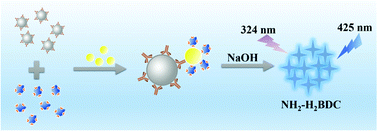Double-site recognition of Staphylococcus aureus using a metal–organic framework material with an alkaline hydrolysis property as a sensitive fluorescent probe†
Abstract
A metal–organic framework (MOF) material was prepared from 2-aminoterephthalic acid and aluminum chloride with a solvothermal synthesis protocol. The as-prepared MOF material named NH2-MIL-53(Al) emitted a very intensive fluorescent (FL) signal after it was hydrolyzed in alkaline solution for releasing numerous FL ligands NH2-H2BDC. Thus it can be considered as a sensitive FL probe for studying biorecognition events. In this proof-of-principle work, a double-site recognition method was established to quantify Staphylococcus aureus (S. aureus) relying on the alkaline hydrolysis property of the MOF material. In particular, magnetic beads (MBs) modified with pig IgG were adopted for binding S. aureus based on the strong affinity between pig IgG and protein A on the bacterial surface. Meanwhile, MOF NH2-MIL-53(Al)-tagged teicoplanin (TEI) was adopted for tracing the target bacteria. By hydrolyzing the MOF material bound on the MBs to trigger the FL signal, S. aureus can be quantified with a dynamic range of 3.3 × 103–3.3 × 107 CFU mL−1 and a detection limit of 5.3 × 102 CFU mL−1 (3σ). The method can exclude efficiently the interference from other common bacteria. It has been applied to quantify S. aureus in saliva, pomegranate green tea, glucose injection and milk samples with satisfactory results, verifying the application potential for analyzing various types of real samples contaminated with S. aureus.

- This article is part of the themed collection: 2021 Nanoscale HOT Article Collection


 Please wait while we load your content...
Please wait while we load your content...